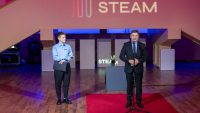Lithuania’s First STEAM Didactics Centre Opened at VMU

“The future of Lithuania lies in the individuals you educate. They must be technically skilled and aesthetically sensitive. Through that combination of technical knowledge and artistic sensitivity, we will create a brighter future by educating students who can combine mathematics, science, and the arts. This is why STEAM centres are so vital,” said Professor Edmond Saliklis from California Polytechnic State University, during his presentation at the opening of the STEAM Didactics Centre at Vytautas Magnus University (VMU).
The new centre is unique – the first and only one of its kind in Lithuania – designed to be the primary space for education professionals to enhance their competencies and deepen their knowledge in STEAM education. STEAM is an integrated, interdisciplinary model for developing students’ skills, combining science, technology, engineering, mathematics, and the arts.
“Without playfulness, we are robots, but without discipline, we are in chaos. The connection, the threshold between the two, is very important. It’s a way to renew teaching and inspire our students. STEAM has its roots in the Bauhaus school in Germany, where artists, architects, and sculptors combined playfulness with discipline, and their motto was ‘Learn by doing’. This motto is also adopted by my university,” Prof. Saliklis noted.
He shared that when he teaches interdisciplinary courses at California Polytechnic State University, such as architectural and civil engineering, he encourages his students to create so-called artefacts – inventive art objects that are based on mathematical and other scientific principles.

The focus is on people, not the buildings
The opening of the VMU STEAM Didactics Centre took place on Friday, 11 October, at the VMU Agriculture Academy. The event attracted two hundred education community representatives, STEAM Centre leaders and methodologists, representatives of education centres, and teachers. More than two hundred pupils also attended the event, where they had the opportunity to try out 18 different STEAM activities, visit modern laboratories, and listen to success stories.
According to Assoc. Prof. Judita Žukauskienė, Head of the VMU STEAM Didactics Centre, STEAM education integrates subjects from different fields using creativity and team activities, which provide students with the opportunity to not only learn more effectively, but also to get to know themselves better, to experiment, and tackle challenges.

Assoc. Prof. Judita Žukauskienė
“Our Centre has several key missions: to enhance the qualifications and development of current teachers in STEAM areas, to train STEAM educators, which are in short supply, and to offer activities for pupils. Buildings alone are worthless. To fulfill our missions, we have people who will help achieve these goals at the Centre,” said the Head of the Centre.
The Centre plans to hold methodological training, seminars, and workshops to further incorporate innovations into the teaching process. Modern laboratories will foster collaboration among scientists, students, educators, and pupils.
From artificial intelligence and drones to agronomy and economics
“We are beginning to understand the harmony of nature and our place in the world – we do not live in isolated areas, so from the very first steps of learning, sciences should be interconnected. We don’t need to think that this will replace mathematics, English, or physics; no, it’s a way to learn about the environment around us in an integral way, because that is how we live,” VMU Rector Prof. Juozas Augutis emphasised the importance of integrating different sciences during the opening of the Centre.

Prof. Juozas Augutis
“The entire Vytautas Magnus University is engaged in STEAM – it’s not just a separate classroom with some equipment. Pupils and teachers can spread out across various labs and centres, which fill all the spaces, from artificial intelligence to agronomy, from economics to drone technology, from mathematics to engineering,” said the Rector, adding that thanks to a recently signed agreement, doctoral students from the Massachusetts Institute of Technology (MIT) will soon come to the university to work with STEAM and assist pupils.
The advisor to the Minister of Education, Science, and Sports on science and general education, Rasa Kulvietienė, also spoke at the opening, wishing everyone success in exploring the mysteries of science and in cooperation. “I wish everyone here to find synergy and cooperation, to foster a culture in which you try to understand each other and use scientific knowledge, but do not forget the most important thing – that it is not only the laboratories that create, but also the people who will gather here to work,” remarked Rasa Kulvietienė.

The future is in the school corridors
During the event, the Mayor of Kaunas District, Valerijus Makūnas, highlighted that collaboration with Vytautas Magnus University has been and remains crucial for the region – a collaboration that led to the establishment of VMU Ugnės Karvelis Gymnasium. “We have signed various agreements to invest in young people choosing teaching as their profession, and it is happening. This is a significant contribution of this university, and I sincerely thank you for it. It’s no secret that our future walks the corridors of schools,” said the mayor.
At the opening of the VMU STEAM Didactics Centre, educators had the opportunity to attend plenary sessions and discussions and participate in two conferences where experts reviewed practical STEAM education solutions and innovative foreign practices for teaching about climate change. Pupils attended a forum on “STEAM Future Perspectives” and practical STEAM workshops.
The event began with a special STEAM performance by VMU students and the Centre’s staff.
More information about the VMU STEAM Didactics Centre.








































